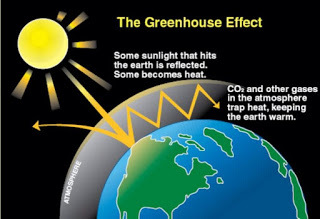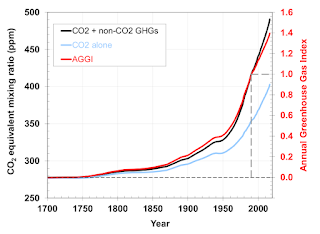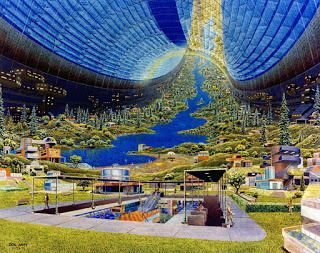Understanding Climate Change
I see no point in debatingwhether the human race should be saved or not. The purpose of this post issimply to offer an alternative to self-destruction because our destruction iswell under way and I have lost all hope.
April 14th,2018West Guilford,OntarioCanada
The weather forecast fortoday is: “Significant snow with ice pellets expected into tonight. Freezingrain beginning Sunday.” For tomorrow the forecast reads, “Sunday morninganother round of ice pellets will move into the region quickly changing tofreezing rain later in the morning. The freezing rain will change over to rainSunday evening. Significant ice buildup is possible on Sunday. Power outagesare possible given the significant ice buildup combined with strong and gustywinds.”We sometimes have an April snowstorm, that is not unusual, but normallyit last one or two days and then it is gone. This “April storm” has been goingon for two weeks now. When I consider the other abnormal weather the world has beenexperiencing this winter I see no reason to doubt that the climate is changing.
2018 in Canada (as well asmany other parts of the world) began with extreme weather. It is all documentedin the following report from the World Meteorological Organization (WMO)which states the following about Canadian weather:In acold snap which started late December, more than 70 low temperature dailyrecords set for long-term stations in Canada with records dating back to 1870sin some cases. The North Pole was 20°C warmer than some southernCanadian Prairie cities. In some locations in southern and central Canada, windchill values dipped between -45°C and -50°C, freezing exposed flesh in aminute.When Ifirst started hearing about climate change it was referred to as “global warming”.My thinking at the time was, great,Canada could be a few degrees warmer. Obviously I didn’t understand what Iwas hearing or the implications. I blame myself partially for that. I am not ascientist, I have Bachelor of Arts degree, and I worked in IT. I expected themedia and my elected officials to have my best interests—and those of everyoneelse they served—in mind when they made decisions. I was naïve, in hindsightthere is no doubt about that, but I truly expected that businessmen would notdestroy our planet's ability to sustain life, that politicians would do what was right for the peoplethey represent, and that the media cared about truth more than profits. Thatdid not happen, so I set out to learn the truth myself.
What is happening to the climate?Itdoesn’t take much searching to identify that greenhouse gases (GHG) areresponsible for what is happening. The GHGs carbon dioxide (CO2),methane (CH4) and nitrous oxide (H2O) are the mainplayers but other short lived pollutants play a part also with black carbon, tropospheric ozone and hydrofluorocarbons (HFCs) chiefamong them. Theyare part of the air we breathe, but the proportions in the atmosphere areincreasing. NOAA NATIONAL CENTERS FOR ENVIRONMENTAL INFORMATION, State of the Climatein 2016 report makes this clear.
https://www.ncdc.noaa.gov/sotc/global/201601
Thisreport is in its 27th year of publication and is contributed to by 468authors from 64 countries; and 16 editors on 3 continents.
How GHGseffect the earth is shown in the following diagram:

The keyfactors are absorption and reflection. More GHGs in the atmosphere means moreheat is radiated back to the earth Science refers to this as “radiation forcing”or “climate forcing” It is defined as “the difference between the sunlightabsorbed by the earth and the energy reflected back to space.”.Because climate change is a direct result of accumulated GHGs in theatmosphere, radiative forcing is seen as the best single metric for assessingglobal climate change. “Since 1990, the radiative heat forcing of the threeGHGs combined has increased by 40%” [4]

I wouldthink that even if no one was telling me about it I would have noticed a 40%heat increase in the last 28 years, but it turns out that about 90% of thatheat increase is stored in the oceans and the ‘ocean thermal lag’ as it iscalled, delays the heating of the surface air, sea, and land. We may not befeeling the heat yet, but it is locked in for the future. The world we leaveour children is going to be hotter than the one we are familiar with. How muchhotter is the question a lot of people are trying to answer accurately.
In 2014the IPCC Assessment estimated that ocean heat lag had committed us to 0.6° C (1.08°F),but not until well after 2100. (It is important to remember that input to theIPCC is from all policy makers of all governments plus leading scientists fromall world regions. Policy makers on the panel review every line of the reportand must agree on the final text before the report is published. Estimates areconservative at best.) Since the report in 2014 further research now suggeststhat we will reach a 1.5°C (2.7°F) increase within the next 10 years. If fact “the voluntary national emission reductioncommitments since Paris now put the world on a path of 3.4°C ofwarming by 2100 , and more than 5°C if high-end risks including carbon-cyclefeedbacks are taken into account.”[5]
There are4 global warming scenarios that scientists work with as shown in the followingchart. There meanings are explained in the chart.

As itsays, the best-case scenario requires the immediate decline of global emissionsin order to stay below the target set in the UN Paris Agreement. We are pastthe point where reducing emissions will guarantee our children’s future. Theonly choice left is to actually reduce the GHGs that are in the environment.
Theeffects of global warming that we are now seeing were not expected to happenthis quickly, and are having repercussions that no one saw coming. Arctic,Antarctic and Greenland glaciers and ice are melting faster causing sea levelsto rise and opening up parts of the oceans that were normally ice covered whichallows the water to absorb more heat. Ocean heat is causing the currents tochange which in turn causes the jet stream to become erratic. Arctic permafrostis melting and releasing more GHG’s into the atmosphere. Is it too late?The consensus among scientists is thatconcerted war-time efforts (similar to the nationwide effort undertaken duringWWII) may be able to limit global warming to 2○ Celsius if the worldstops all carbon emissions now. Unfortunately many of the major westerncountries like the USA are ignoring the warning and insist on pursuing businessas it was in the boom years of the early 20th century. Worse still,some countries like Canada say they are committed to the effort, but continueto invest in oil and gas exploration and technology like pipelines.
https://www.nationalobserver.com/2018/03/06/analysis/theres-some-good-news-about-canadas-2020-climate-targethttps://www.huffingtonpost.ca/2018/05/29/canada-to-buy-trans-mountain_a_23445896/
Worse yet, some politicians in Canadianprovinces—provinces are the equivalent of states in the US—are following thetrend occurring in the US recently and dismantling efforts that are underway.Doug Ford, leader of the newly elected Conservative provincial government inthe province of Ontario, has stopped the Cap and Trade system in Ontario.
https://torontosun.com/news/provincial/doug-ford-ends-cap-and-trade-in-ontario
Efforts and legal challenges areunderway to stop these actions, but is it enough to counteract the money andeffort made by the large oil and gas industry since the 1980s to discredit thescience? I do not believe it is.
https://insideclimatenews.org/news/05062017/exxon-climate-change-fraud-investigation-eric-schneiderman-rex-tillerson-exxonmobil
Despite winning some of the legalbattles recently, my belief the human race will destroy the ability of thisplanet to sustain us has not changed. By all means, do not give up the fight,but don’t put the survival of the race in the hands of those currently ignoringthe conditions or even the population in general. We are not going to changeour lifestyles in the ways being proposed. We are not going to give up eatingmeat, or cattle ranching, or dairy farming, or using plastic, or heating withgas/wood/oil. The planet will survive, but the environment will be toxic tohumans and most current life.
https://www.resilience.org/stories/2018-05-09/humans-didnt-exist-the-last-time-there-was-this-much-co2-in-the-air/
“Scientists estimatewe're now losing species at 1,000 to 10,000 times the background rate, withliterally dozens going extinct every day [1]. Itcould be a scary future indeed, with as many as 30 to 50 percent of all speciespossibly heading toward extinction by mid-century”
https://www.scientificamerican.com/article/climate-change-is-becoming-a-top-threat-to-biodiversity/Whatcan be done?
Some people are sending their hope intospace. Colonies on the Moon and Mars have been suggested. Getting off ourplanet may be a viable option for 98.5 percent of the people. Doyou think you or your children will be included in those who colonize other worlds?I won’t be one of them. I am too old. My children, now between thirty and fortyyears old are not in professions that will be useful, so they will see theeffects of climate change in their lifetimes, but will have no escape option,unless we start to build off-world type colonies (new towns) on earth, startingnow.
The concept of large scale spacecolonies has been around for many years. I believe they were first proposed by Freeman John DysonFRS (born 15 December 1923) an English-born American theoretical physicist and mathematician. Themost famous is probably the O’Neill Cylinder, designedby Princeton physicist Gerard K. O’Neill. This design, is referred to as“Island 3” or 3rd- generation space colony. Consists of a pair of cylinders,each 20 miles long and 4 miles in diameter, the total land area inside thecylinders is about 500 square miles and can house several million people.

Building new enclosed cities using‘space colony’ technology and concepts, but locating them here on earth insteadof off-world is one way of ensuring that human’s survive the GreatAcceleration. When I think of this type of city Iimagine a large enclosed (domed?) space where the structure itself generatespower through solar, wind and geothermal means and collects water from rainfalland wells. All consumables are grown and produced by the city’s population. Insimple terms the city is self-contained and self-managed. The concept followsthe current thinking of community based resources, but the idea is for a citywide community where resources are designed and built into the structure.
Building these ‘colonies’ on earthinstead of in space would be less expensive. Research at Cornell University isnow estimating that two billion people will be displaced by raising sea levels.We will need to build housing and structure for them, and I would like to seesustainable energy conscious structures instead of refugee camps.
“By 2060, about 1.4 billion people could beclimate change refugees, according to the paper. Geisler extrapolated thatnumber to 2 billion by 2100.” http://news.cornell.edu/stories/2017/06/rising-seas-could-result-2-billion-refugees-21002060 is only forty-two (42) years away.I won’t see it, but my children will allowing they can still breathe the airaround them, find enough food to eat and clean water to drink. Where do peoplego when food, water and breathable air are not available?
https://public.wmo.int/en/media/news/start-of-2018-marked-extreme-weather
Blunden,J. and D. S. Arndt, Eds., 2017: State of the Climate in 2016. Bull. Amer. Meteor. Soc., 98 (8), Si–S277,doi:10.1175/2017BAMSStateoftheClimate.1. Page 226, UnprecedentedCrime-Climate Denial and Game Changers for Survival, Dr. Peter D. Carter &Elizabeth Woodworth, 2018. Page 226,Unprecedented Crime-Climate Denial and Game Changers for Survival, Dr. Peter D.Carter & Elizabeth Woodworth, 2018 http://www.resilience.org/stories/201... This figure is notcompletely arbitrary. It represents the 1% who control/possess most of thewealth plus a small percent of drudges they will need if artificialintelligence does not work out the way they hope for. The Great Accelerationrefers to the most recent period of the Anthropoceneduring which the rate of impact of human activity upon the Earth's geology andecosystems is increasing significantly. While the Anthropocene commenced with Industrial Revolution if not long before, the Great Acceleration begins in the20th century with the acceleration rate dramatically increasing after the Second World War.[1]This concept has been further extended to refer to the rate of change intechnology and society as a whole
Published on July 15, 2018 10:04
No comments have been added yet.



